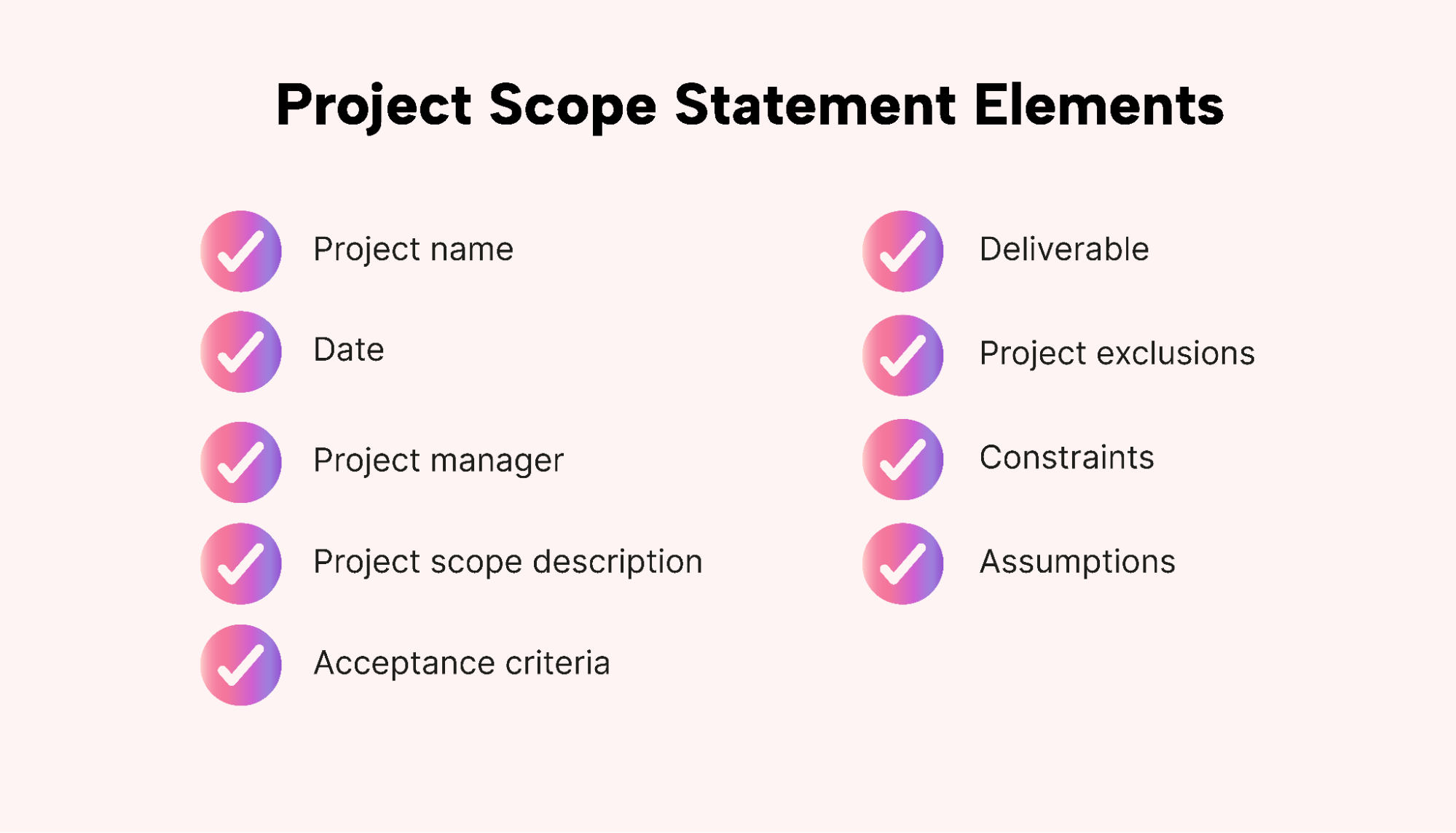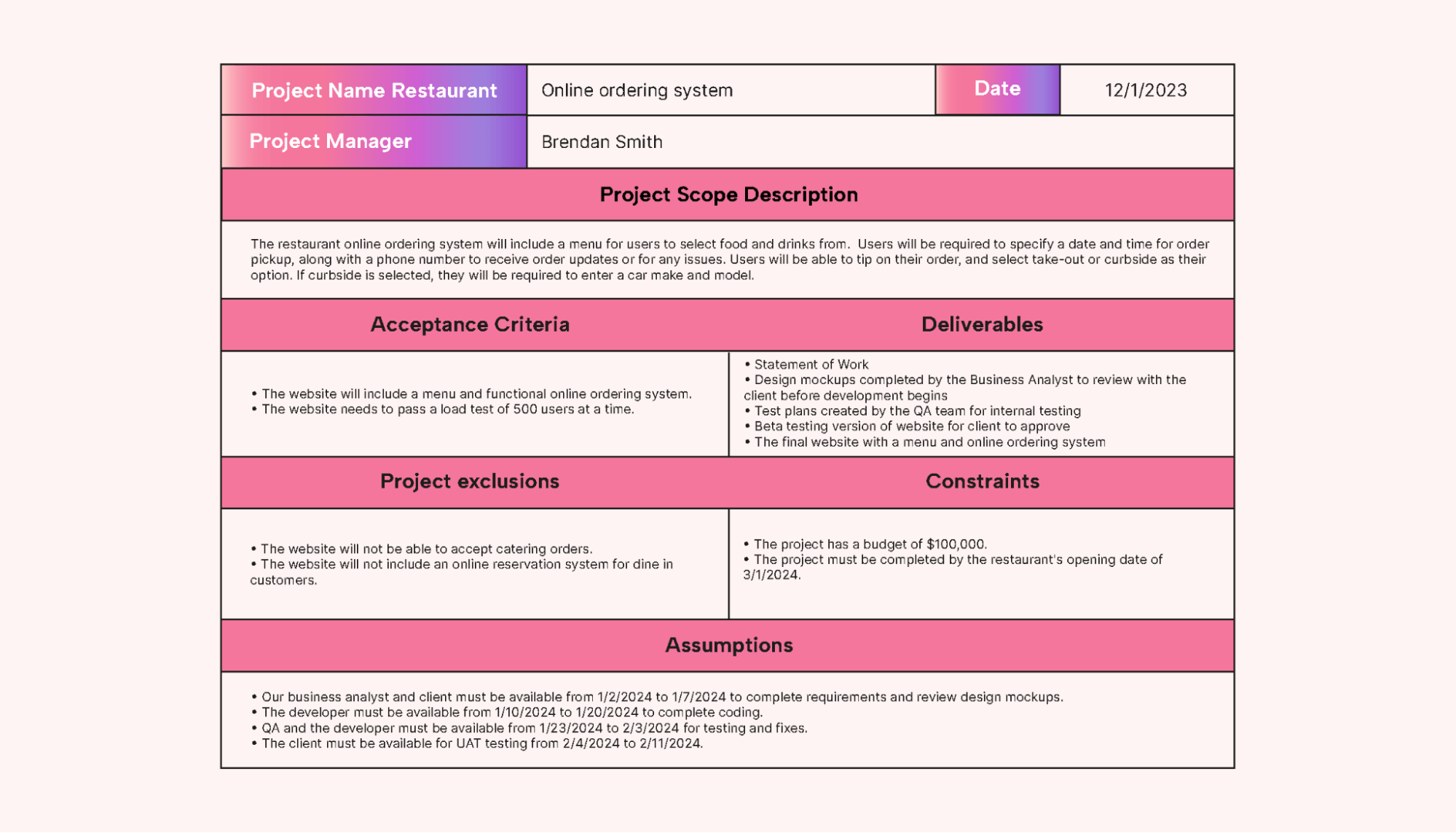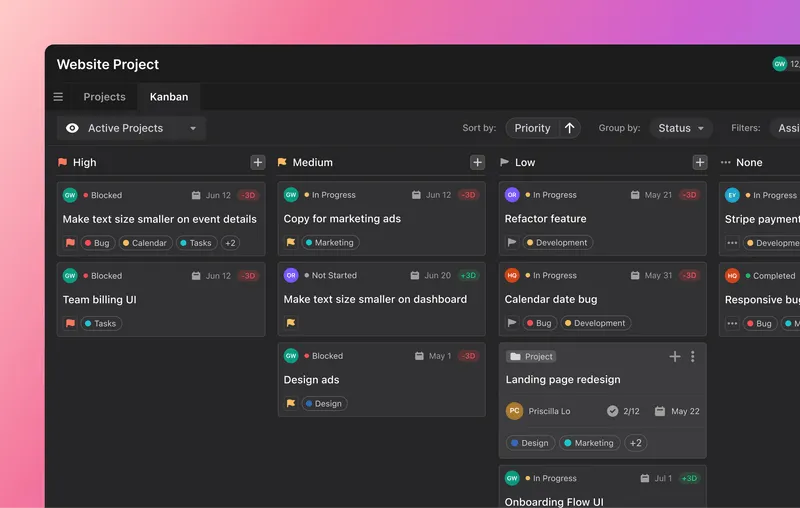Have you ever been a part of a project that was a victim of scope creep?
Perhaps you're part of a software development team where an account manager agrees to more features or enhancements that are already in development. You work overtime and still miss deadlines.
Or maybe you work for a tree removal company and arrive at jobs where clients decide they want "a few more trees trimmed." Customers don't understand that your schedule backs up if you take on additional requests.
Consider using a project scope statement if your projects run behind schedule or are over budget due to scope changes.
In this article, we’ll discuss the following:
- What is a project scope statement?
- What elements are included in the scope statement?
- How to develop a scope statement
- An example scope statement
- Tracking project scope
- Benefits of a scope statement
What is a project scope statement?
A project scope statement is a document that sets the project boundaries of what the project team will accomplish.
Usually, a project manager develops the scope statement with input from the project stakeholders.
The project team and stakeholders can use the project scope statement to gauge scope changes against (and measure the success of a project).
What elements are included in the scope statement?
Now that you have a general idea of what a project scope document is, let's go over the elements you should include.
Project name
Maybe obvious, but you’ll want to include the project name when writing the scope statement.
Date
When you write the scope statement, include the date you wrote the scope statement. This timestamp is important if and when scope changes pop up in the project.
Update this date to the final date of the scope statement when it's ready for sign-off.
Project manager
Identify the person managing the project.
Project scope description
The scope description includes the business objectives that the team needs to accomplish for the successful completion of the project.
Acceptance criteria
Acceptance criteria are conditions that the project needs to meet for the client to accept deliverables.
Project Deliverables
Project deliverables are outcomes of project tasks. They can be internal or external.
For example, meeting notes or status reports used by your team are internal deliverables.
External deliverables would be business requirements that are sent to a client for approval or the (final, major deliverable) website that a development team built for them.
Project exclusions
Project exclusions are items that are excluded from a project, or out of scope.
Agile teams can add suggestions to a backlog for consideration in a future project so they aren’t lost. Identifying exclusions that don’t fit the constraints (we’ll discuss this more in the next section) of a project can help manage scope creep.
Teams following the waterfall methodology can use a change management process. If a client requests additional work, to a project, the change is evaluated for the time and cost needed to implement the change. If the change is approved, the project schedule and budget are updated to reflect the change.
Constraints
The top three project constraints, or triple constraints, are time, money, and scope.
A change in one of the triple constraints will affect the other two. For example, a scope change will impact the project timeline or the project budget (or both).
Other common constraints include project risks and available resources.
When you have conversations with customers and stakeholders about the project, keep an eye out for statements about “nice to haves”. These items have the potential to become scope creep.
Make sure all stakeholders agree on what is a part of the project and what isn’t.
If the customer or key stakeholders add new items to the scope document before it is finalized, make sure everyone is on board with increasing the budget and changing the project timeline.
The goal should always be that the scope statement is doable.
For example, if a team is working on a website development project for a restaurant's online ordering system, the original agreement for phase one of the website might be to allow users to place carryout orders. If the restaurant asks for enhancements, such as an option to let the restaurant know you are coming via GPS tracking, it’d increase the cost and time to complete the project.
Assumptions
Assumptions are factors relating to a project that are considered to be true or certain.
For example, if the team needs supplies by a certain date, it’d be an assumption that the supplies are available on that date. Another assumption is that team members will be available to complete their parts of the project when needed.
How to develop a scope statement in 3 steps
Now that we know what to include in a project scope statement, let's look at the steps to develop the document.
Determine project goals
What does the team need to accomplish for the project to be considered a success? What’s your customer looking for?
For example, a construction company remodeling a shower would have a goal of removing old tile and plumbing fixtures and replacing everything with new materials. The goal would be a new shower. If you finish the project a month after the promised completion date and for $5,000 more than the quote, you won’t have a satisfied customer.
Identify deliverables
Document what the team needs to deliver for the project (we've already covered what a deliverable is).
If a team is working on a website development project, example deliverables would include a project plan, business requirements of the website, test plans, and the programmer’s code.
Obtain sign-off from stakeholders and customers
When the project scope statement is complete, you'll want to have your stakeholders and customers sign off on it to ensure everyone is on the same page (before work begins).
It's always easier to get sign-off if you collaborate with those customers and stakeholders (and get their input) while developing the scope document.
An example scope statement
Let’s take a look at an example scope statement below.
 |
Let's assume our project team is a software development team designing website functionality to allow users to place online orders (for a restaurant).
Project name
Our project is called “Restaurant online ordering system.”
Date
The date of our document is 12/1/2023.
Project manager
Our project manager is Brendan Smith.
Project scope description
The team needs to understand the client's end goal to determine the scope. The client must agree on what'll be included in this project (and what needs to be put on the back burner for a future project).
Our client agrees that our online ordering system will only be for takeout orders.
The scope statement: “The restaurant’s online ordering system will include a menu for users to select food and drinks. Users will be required to specify a date and time for order pickup and a phone number to receive order updates or any issues. Users can tip on their order and select takeout or curbside as their option. If curbside is selected, they must enter a car make and model.”
Acceptance criteria
The customer and other stakeholders need to determine what thresholds need to be met for each deliverable for them to be accepted.
The stakeholders agree that the web page for online ordering must be functional (i.e., usable) and be able to pass a load test of 500 users at a time.
Deliverables
The deliverables of the project will be:
- A statement of work before work begins.
- Design mockups of the website (they’ll be delivered by the business analyst to the client for acceptance of the design before work begins).
- The QA team will create test plans for internal use to verify that the site is functional.
- The programming team will send the client a version of the website that has passed QA (the client will use this version for Beta Testing).
- The final website, including the menu and online ordering system.
Project exclusions
The stakeholders may have additional functionality they'd like for their online ordering. These may be done in a future project.
For example, the customer might like users to be able to place large catering orders. Catering orders will be excluded from the current project (due to having different menu options than traditional takeout orders). The client also agrees that a reservation system for guests to reserve a table online can wait until the next phase.
Constraints
Assumptions include that the team will be available as follows:
- The business analyst will be available from 1/2/2024 to 1/7/2024 to complete project requirements.
- The customer will be available for meetings and discussion and to approve design mockups during the entire project lifecycle.
- The developer will be available from 1/10/2024 to 1/20/2024 to complete coding.
- The QA tester and developer will be available from 1/23/2024 to 2/3/2024 for QA to test, and the developer to make fixes.
- The customer will be available for Beta Testing by the client from 2/4/2024 to 2/11/2024.
Here's our final scope statement.
 |
Benefits of a scope statement
Setting Boundaries
Setting boundaries in a scope statement prevents scope creep, additional costs, and delays. When a customer asks for work, the scope statement can be referenced to determine if the work falls within the agreed-upon scope.
Project Planning
The team can plan project tasks and resources more accurately when they have clear project boundaries. Accurate planning is essential for on-time project completion.
Accurate Budgets
Budgeting is easier and more accurate when you have a clear project scope. More accurate budgeting not only is important for the project, but your bottom line.
Common Understanding
When the customer and relevant stakeholders give input up front, it helps ensure everyone is on the same page (about what's included in the project).
A common understanding also makes for smoother project lifecycles. Fewer changes along the way to disrupt the workflow. Deadlines are more realistic.
Track work (against project scope)
Once you have an agreed-upon scope statement, you can track project tasks to make sure agreed-upon schedules and deliverables are running on time.
Reference the agreed-upon project scope statement when new requests come up. Consider offering options such as a “phase 2” for additional work.
If project assumptions change, such as someone not being available when expected, look for workarounds. Can another team member cover if someone is unavailable for their assigned part?
Use Motion to manage deliverables of your project scope
Once you define your project scope statement, consider using Motion to manage the tasks needed to complete your deliverables.
Motion’s project management features will create a plan for your team by adding work to your team members’ calendars. Motion automatically considers other priorities to ensure that everything that needs to be done is accomplished on time.
If a team member is overscheduled and a task is completed after its due date, an alert is generated (so the team can figure out a workaround).
Motion features Kanban views to show the status of all tasks, which helps you track progress and tackle bottlenecks as they come up.
If you aren't already using Motion, access a free trial today.






